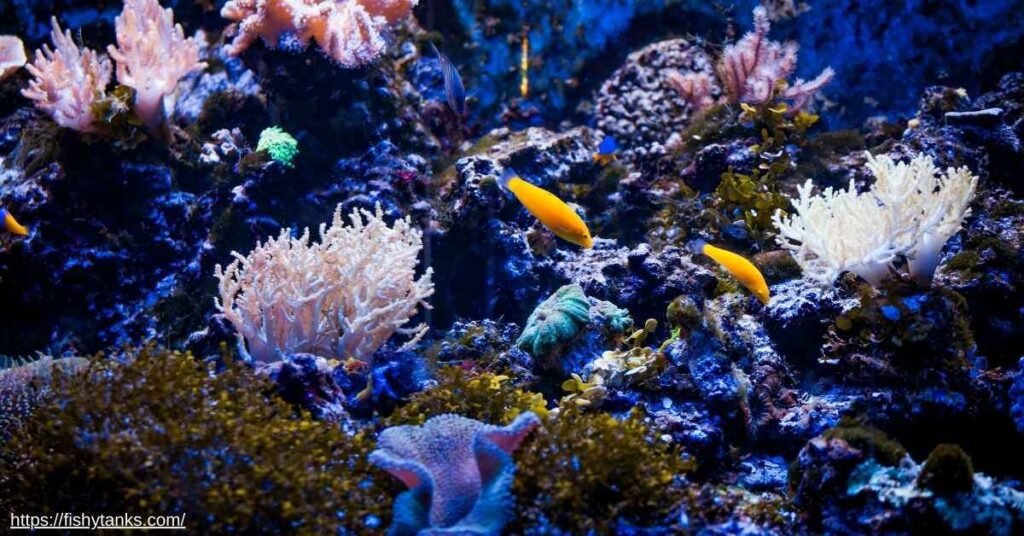Introduction
Setting up a saltwater fish tank can seem daunting, but with the right guidance, it can be a fun and rewarding experience. In this article, we will walk you through the easy steps to set up your saltwater fish tank, from choosing the right equipment to introducing your fish to their new home.
Table of Contents
Good Size For Saltwater Fish Tank
- Small: 40-gallon breeder or 60 cubes or 93 square
- Medium: 120-gallon rectangle
- Large: 180-gallon rectangle
- Extra large: 207-gallon CADE Reef PR2-1800
- Beginner: 50-175 gallons
The following is a guide when selecting a size:
- Space where the tank will go
- Type and number of fish you want
- Budget for equipment and maintenance
- Skill level, as larger tanks can be more challenging to maintain
- Commitment to the hobby, as larger tanks require a longer commitment

Simple Steps to Set Up Your Saltwater Fish Tank
Step 1: Choose the Right Equipment
Selecting the right equipment is the first step to set up your saltwater fish tank. You’ll need to choose a suitable tank size and material, as well as a filtration system, heater, thermometer, and protein skimmer. Be sure to research and choose equipment that is compatible with your tank size and the type of fish you want to keep.
Step 2: Set Up Your Tank
When you have all the necessary equipment, then it is time to put your tank in place. Start by assembling the tank and stand, making sure it is level. Then, add substrate and decorations, such as live rock and coral, to create a natural environment for your fish.
Step 3: Cycle Your Tank
Before you can introduce your fish to their new home, you need to cycle the tank. This involves allowing the tank to establish beneficial bacteria, which will help keep the water clean and healthy. You can use a fishless cycle method, which involves adding ammonia to the tank to simulate the presence of fish. Monitor the water parameters and perform regular water changes to ensure a healthy environment.
Step 4: Select the Right Fish
When choosing fish for your tank, it’s important to select species that are compatible with each other and with the tank’s water parameters. Research different species and choose fish that are suitable for beginners.
Step 5: Introduce Your Fish
Once your tank is set up and cycled, it’s time to introduce your fish to their new home. Acclimate your fish to the tank’s water parameters and then release them into the tank.
Step 6: Maintain Your Tank
To keep your fish healthy and thriving, it’s important to maintain your tank regularly. Monitor the water parameters and perform regular water changes. Clean the tank and equipment regularly to ensure a healthy environment for your fish.

When to Add Fish to a New Saltwater Tank
When you set up your saltwater fish tank, it is important to wait before adding fish. This allows the tank to cycle and establish a healthy balance. The cycling process can take anywhere from 2-6 weeks. During this time, beneficial bacteria grow and start to break down waste. If you add fish too soon, they may die from ammonia and nitrite poisoning. Wait until the tank’s water parameters are stable and safe for fish. The levels of ammonia, nitrite, and nitrate should be monitored frequently. When they reach zero, it’s a good sign the tank is ready. Also, make sure the tank’s pH and temperature are stable. Once the tank is cycled and stable, you can introduce your fish.
Can I mix salt directly in my aquarium?
Mixing salt directly in your aquarium is not a recommended practice in saltwater aquarium keeping. Here’s why:
1. Inaccurate mixing
Saltwater aquariums require a specific gravity (SG) of 1.020-1.025, which is difficult to achieve by mixing salt directly in the tank. Incorrect mixing can lead to water parameters that are harmful to fish and other marine life.
2. Uneven distribution
Salt may not dissolve evenly throughout the tank, creating areas with high salt concentrations that can be harmful to fish and corals.
3. Stress to fish
Sudden changes in water chemistry can stress or even kill fish. When salt is mixed directly in the tank, it can cause rapid changes in water parameters, putting fish at risk.
4. Corrosion risk
Saltwater can corrode tank equipment and decorations if not properly rinsed. Mixing salt directly in the tank increases the risk of corrosion, which can lead to equipment failure and tank damage.
5. Difficulty in maintaining water parameters
When salt is mixed directly in the tank, it becomes challenging to maintain stable water parameters. This can lead to fluctuations in pH, alkalinity, and calcium levels, making it difficult to maintain a healthy environment for fish and corals.
To avoid these issues, it is recommended to mix salt in a separate container, known as a brine solution, before adding it to the tank. This approach allows for:
- Accurate mixing and control of specific gravity
- Even the distribution of salt throughout the tank
- Gradual changes in water chemistry, reducing stress on fish
- Reduced risk of corrosion and equipment damage
- Easier maintenance of stable water parameters

Common Mistakes to Avoid in Saltwater Fish Tank Setup
Setting up a saltwater fish tank can be a complex process, and even experienced aquarists can make mistakes. Here are some common mistakes to avoid when set up your saltwater fish tank:
Insufficient research: Not researching the specific needs of your fish and tank size can lead to incompatible species, inadequate space, and poor water quality.
Improper tank cycling: Not allowing the tank to cycle properly can lead to the death of your fish due to ammonia and nitrite poisoning.
Inadequate filtration: Not providing sufficient filtration can lead to poor water quality and the buildup of toxins.
Overcrowding: Adding too many fish to the tank can lead to stress, disease, and water quality issues.
Incompatible decorations: Using decorations that are not designed for saltwater tanks can lead to the release of harmful chemicals and the death of your fish.
Not monitoring water parameters: Not regularly testing the water for pH, ammonia, nitrite, and nitrate can lead to water quality issues and the death of your fish.
Tips and Tricks for a Successful Saltwater Fish Tank Setup
- Start small (less than 50 gallons) to gain experience and build confidence.
- Choose hardy fish that can tolerate minor water quality issues.
- Invest in high-quality equipment like protein skimmers and LED lighting.
- Perform regular water changes (10-15% every week).
- Monitor water parameters (pH, ammonia, nitrite, nitrate) regularly.
- Provide adequate hiding places (rocks, crevices, decorations).
- Avoid overfeeding to prevent excess food decay.
- Let the tank cycle before introducing the fish.
- Learn from experienced saltwater aquarists.
- Be prepared to troubleshoot and address unexpected issues.
- Research and plan carefully before setting up your tank.
- Join online communities for support and guidance.
- Keep a log to track water parameters and tank maintenance.

Conclusion
Setting up a saltwater fish tank requires careful planning and attention to detail. Following the easy steps outlined in this guide, you can successfully set up your tank and enjoy the beauty of saltwater aquarium keeping. Remember to choose the right equipment and supplies, select compatible fish and invertebrates, and cycle your tank to establish a healthy biological balance. Monitor and maintain optimal water parameters, perform regular water changes and tank maintenance, and avoid common mistakes. With patience and dedication, you can set up your saltwater fish tank that will bring you joy and relaxation. Saltwater aquarium keeping is a rewarding hobby that requires commitment and attention to detail.
FAQ’s
Q1: How long does it take to set up a saltwater fish tank?
Setting up a saltwater fish tank can take anywhere from a few days to several weeks, depending on the size of the tank and the equipment needed.
Q2: What is the most important thing to consider when setting up a saltwater fish tank?
The most important thing to consider is the cycling process, which allows beneficial bacteria to establish themselves in the tank, making it safe for fish.
Q3: How often should I perform water changes in my saltwater fish tank?
Regular water changes (usually 10-15% every week) are crucial to maintain water quality and prevent the buildup of toxins.
Q4: What is the recommended size for a beginner’s saltwater fish tank?
A smaller tank (less than 50 gallons) is recommended for beginners, as it is easier to maintain and allows for a more stable environment for fish.
Also Must Read More: I Unplugged my Fish Tank Filter and now it won’t work



